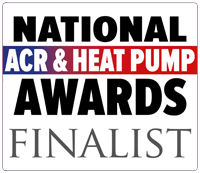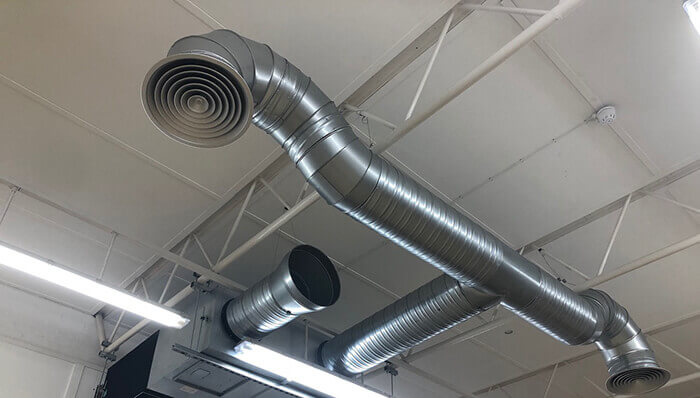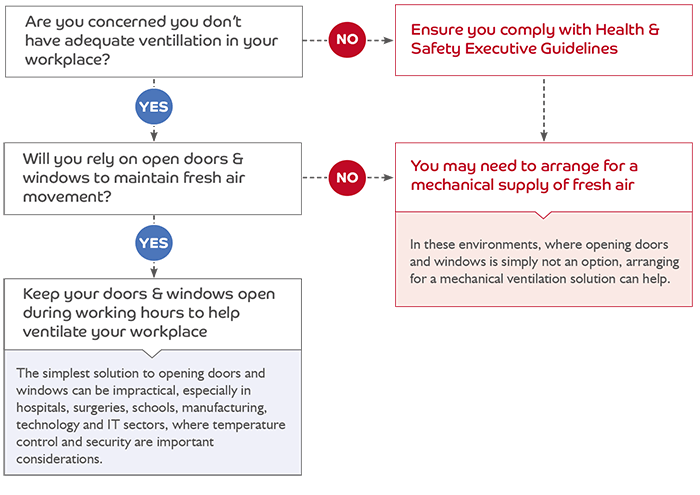


A safer working environment – a simple guide

Going Back To Work
Providing Adequate Ventilation in the Workplace
As more organisations and businesses plan a return to a busier working environment, some key issues should be considered to ensure the wellbeing of colleagues and customers.
Building Regulations have long stated employers ensure there’s an adequate supply of fresh air (ventilation) in enclosed areas of the workplace, equating roughly to a supply of at least 10 litres per second of fresh air.
During the pandemic, the emphasis on delivering fresh air combined with air movement has been highlighted as vital in helping prevent the spread of viruses, bacteria and airborne pollutants, not just in the workplace but, public spaces, schools, hospitality venues and sports halls alike.
So, as the weather turns colder, how do you ensure you provide adequate fresh air combined with air movement (ventilation) to ensure you can continue to provide a suitable environment?
Anyone reading Government and UK Health & Safety Executive (HSE) guidance during the pandemic will be aware that providing adequate ventilation and air flow can be achieved in two ways:
- Natural ventilation or passive airflow – fresh air brought in through open external windows, doors or air vents.
- Mechanical ventilation – fans and ducts bring in fresh air from outside and working in conjunction with air conditioning systems, can provide important supplementary air movement.
The solution for creating the safest environment ultimately starts with a risk assessment, reviewing your current solutions and determining what you need to do the meet Government guidelines.
For example, the first option of opening external doors and windows to provide fresh air may be appropriate during Summer but, is it practical during Winter?
Or is it an option at all if you don’t have doors and windows to open?
Moreover, does it provide the necessary air movement to avoid stagnant air in rooms?
Undertaking your risk assessment
The first step you may want to take when assessing your ventilation requirements as follows:
Mechanical ventilation systems
Developments to building standards, regulations, and an increasing focus on energy efficiency over the last few years has meant that as buildings become increasingly airtight, so the demand for mechanical ventilation systems increases to help supply fresh air into the building
In simple terms mechanical fans drive mechanical ventilation. Fans can either be installed directly in windows or walls, or via ceiling mounted air ducts to supply air into, or exhausting air from, a room.
Mechanical ventilation is used to control the quality of the air within a room or building and the complexity of the system will depend upon the building use and size of room.
For larger spaces, heat recovery ventilation (HRV) systems may be a consideration as the mechanical fresh air supply is tempered, filtered and heated with the recovered warmth from the extracted air inside the building. These solutions are often beneficial for sports halls, venues and community centres which are occupied all year round and temperature control is an important consideration.
One distinct advantage of mechanical ventilation, especially during Winter is the system operates in all weather conditions and with no open doors or windows, external noise outside of the building is not a factor.
We often specify for Clients a combination of mechanical ventilation system, with air conditioning delivering supplementary air movement and temperature control.
Practical solutions are available
Whatever your business environment and your air quality requirements this Winter they are solvable, there is a solution you just need to engage with the right people to help you get there.
Do not hesitate to contact Spheretech about any ventilation, air conditioning or air purification requirements for your workspace. We offer a free no obligation survey to determine the appropriate recommendation for your indoor space.
If you would like more information on mechanical ventilation and air conditioning systems for your commercial premises, please email [email protected] or call 01327 810 510.
Arrange a free no obligation survey
Please provide brief details below and we will contact you to discuss your project.If you would rather speak to someone to arrange a free no obligation survey, or enquire about our maintenance packages, then please give us a call on the number below.
01327 810 510
You can read our Privacy Policy here
